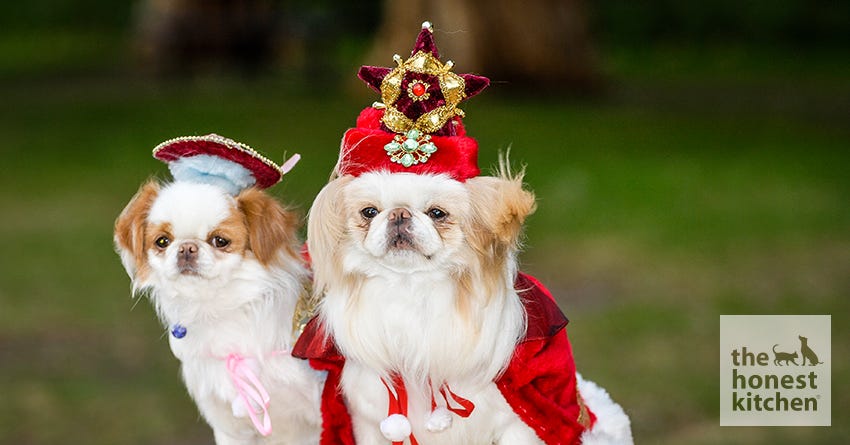From the Orient to Egypt to Europe, some dog breeds have enjoyed very regal lives.
Read on for some of the favorites of royalty, past, and present—you never know, you might be in the presence of royalty!
Pekingese
The Pekingese has a long history with the Chinese court. They were selectively bred to look like the Chinese statues of stylized lions. They tend to be rather dominant dogs. At one time, only those within the imperial palace were allowed to own or breed Pekingese. If a commoner so much as crossed paths with a "Lion Dog", the person had to bow. Stealing a Pekingese was an offense that carried a death sentence.
They were bred tinier and tinier until they could be carried in the sleeves of the billowing robes of those in the palace. Despite all the selective breeding, though, the DNA of the Pekingese is one of the closest matches to wolves, indicating they are a very ancient breed.

©istock.com/molchanovdmitry
Shih Tzu
The origins of the Shih Tzu are somewhat obscure, but it is thought to be of Tibetan origin as one of the oldest and smallest of the Tibetan "holy dogs." The supposed ancestors of the Shih Tzu arrived in China in the 1600's during the Qing Dynasty, as gifts from Tibet to the Chinese emperors. They remained a symbol amongst the Chinese court until the Communist revolution in the late 1940s.

©istock.com/Przemys?aw Iciak
Japanese Chin
Despite its name, this breed is another that was a favorite of Chinese nobility. It was originally developed as a companion dog for the ladies of the Imperial Palace. It also warmed the laps of Chinese aristocracy and is related to the Pekingese.
There are several stories of how the little dog made its way to Japan, but however it got there, it became a favorite of the Japanese Imperial family. It's still a favorite breed in Japan.

©istock.com/asiafoto
Pharaoh Hound
The Pharaoh Hound is another ancient breed, and dates back to around 3000 B.C. King Tutankhamen was said to have a Pharaoh Hound named Abuwityus. King Tut was so fond of his pet, that when Abuwityus died, the dog was buried as though he were a nobleman: in a coffin with perfume, fine linen, and incense. A statue of what appears to be a Pharaoh Hound was found at the entrance of King Tut's tomb.
The breed was kept pure for 2000 years by the ancient breeders, so Pharaoh Hounds today still look very much like their ancient ancestors. Also, it's the National Dog of Malta.

©istock.com/DevidDO
Greyhound
Greyhounds are yet another ancient breed, found in the ancient courts of Egypt, Greece, and Persia. Some ancient Egyptian tombs held the mummified remains of Greyhounds, and old depictions of their anceint courts often have greyhounds pictured.
For a time, the breed fell out of favor, but by the Middle Ages greyhounds were again friends of nobility. Greyhounds could only be owned and bred with permission from the King. And killing a greyhound was a capital offense.

©istock.com/SvetaElfimova
Pembroke Welsh Corgi
The Corgi can be traced back as a friend of English royalty at least as far as King Henry I of England, who reigned from 1100—1135. There are two types of Corgis: the Pembroke Welsh Corgi (known as the Corgi without a tail) and the Cardigan Welsh Corgi (the Corgi with a tail).
Although the Pembroke Welsh Corgi is the younger of the two Corgi breeds, it's also the most popular. Queen Elizabeth II of England still has a great fondness for them. And who can blame her?

©istock.com/bruev
Other Breeds of Nobility
Many other breeds of dogs have been favorites of nobility through the years. For example, the Great Pyrenees was a French court dog in the 17th century.
The Bichon Frise, (which means "fluffy white dog") was a favorite in France during the Renaissance and a particular favorite of both King Francis I and King Henry III. This little dog was also favored by the Italian nobility in the 14th century and quite popular in Spain.
The Coton de Tulear was considered the Royal Dog of Madagascar. It originated in Madagascar in the 17th century and was kept by the Merina, the ruling monarchy there.
Even if your dog isn't included in this list of friends of royalty and nobility, chances are very great that your dog is the King or Queen of your domain. At least in your dog's eyes.

 ©istock.com/molchanovdmitry
©istock.com/molchanovdmitry ©istock.com/Przemys?aw Iciak
©istock.com/Przemys?aw Iciak ©istock.com/asiafoto
©istock.com/asiafoto ©istock.com/DevidDO
©istock.com/DevidDO ©istock.com/SvetaElfimova
©istock.com/SvetaElfimova ©istock.com/bruev
©istock.com/bruev